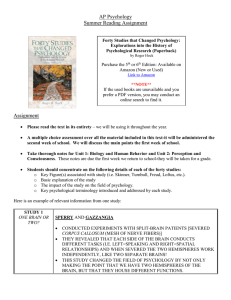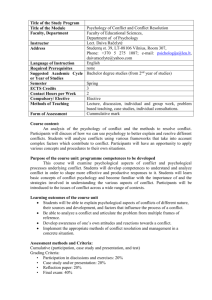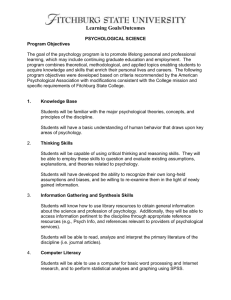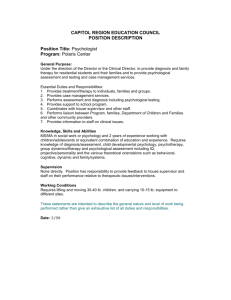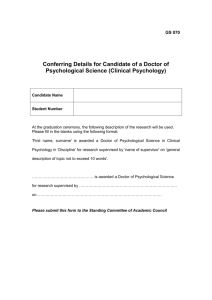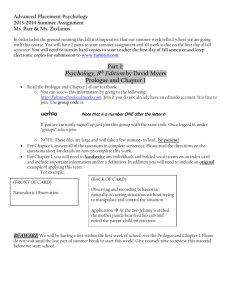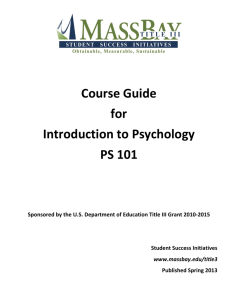AP Psychology
advertisement
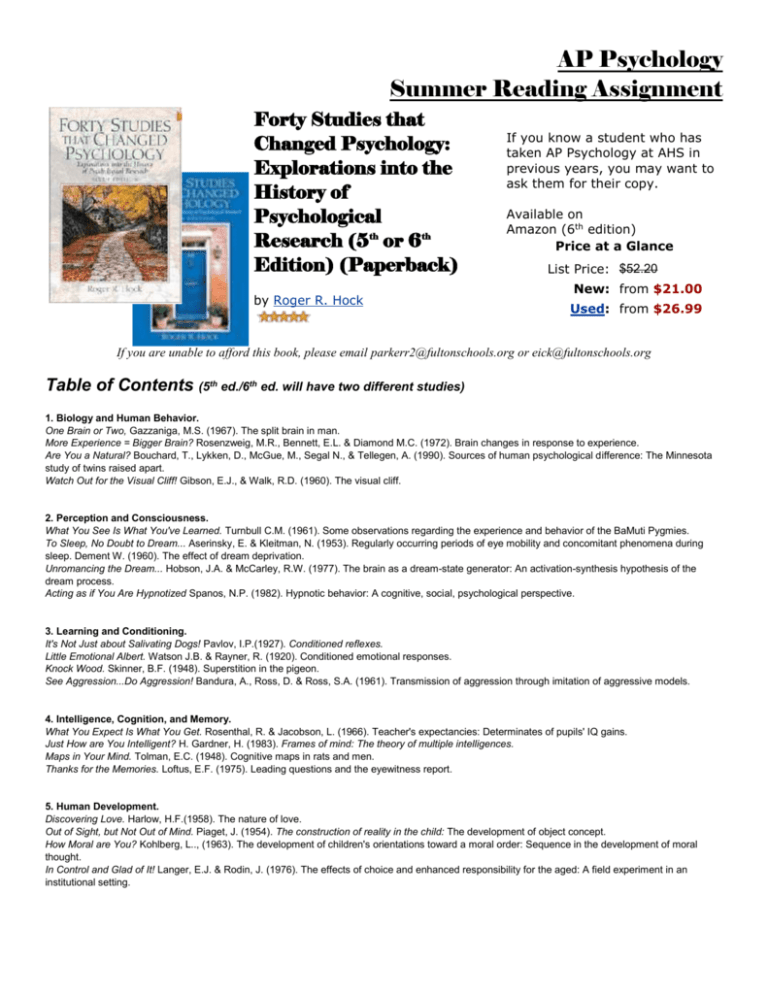
AP Psychology Summer Reading Assignment Forty Studies that Changed Psychology: Explorations into the History of Psychological Research (5th or 6th Edition) (Paperback) by Roger R. Hock If you know a student who has taken AP Psychology at AHS in previous years, you may want to ask them for their copy. Available on Amazon (6th edition) Price at a Glance List Price: $52.20 New: from $21.00 Used: from $26.99 If you are unable to afford this book, please email parkerr2@fultonschools.org or eick@fultonschools.org Table of Contents (5th ed./6th ed. will have two different studies) 1. Biology and Human Behavior. One Brain or Two, Gazzaniga, M.S. (1967). The split brain in man. More Experience = Bigger Brain? Rosenzweig, M.R., Bennett, E.L. & Diamond M.C. (1972). Brain changes in response to experience. Are You a Natural? Bouchard, T., Lykken, D., McGue, M., Segal N., & Tellegen, A. (1990). Sources of human psychological difference: The Minnesota study of twins raised apart. Watch Out for the Visual Cliff! Gibson, E.J., & Walk, R.D. (1960). The visual cliff. 2. Perception and Consciousness. What You See Is What You've Learned. Turnbull C.M. (1961). Some observations regarding the experience and behavior of the BaMuti Pygmies. To Sleep, No Doubt to Dream... Aserinsky, E. & Kleitman, N. (1953). Regularly occurring periods of eye mobility and concomitant phenomena during sleep. Dement W. (1960). The effect of dream deprivation. Unromancing the Dream... Hobson, J.A. & McCarley, R.W. (1977). The brain as a dream-state generator: An activation-synthesis hypothesis of the dream process. Acting as if You Are Hypnotized Spanos, N.P. (1982). Hypnotic behavior: A cognitive, social, psychological perspective. 3. Learning and Conditioning. It's Not Just about Salivating Dogs! Pavlov, I.P.(1927). Conditioned reflexes. Little Emotional Albert. Watson J.B. & Rayner, R. (1920). Conditioned emotional responses. Knock Wood. Skinner, B.F. (1948). Superstition in the pigeon. See Aggression...Do Aggression! Bandura, A., Ross, D. & Ross, S.A. (1961). Transmission of aggression through imitation of aggressive models. 4. Intelligence, Cognition, and Memory. What You Expect Is What You Get. Rosenthal, R. & Jacobson, L. (1966). Teacher's expectancies: Determinates of pupils' IQ gains. Just How are You Intelligent? H. Gardner, H. (1983). Frames of mind: The theory of multiple intelligences. Maps in Your Mind. Tolman, E.C. (1948). Cognitive maps in rats and men. Thanks for the Memories. Loftus, E.F. (1975). Leading questions and the eyewitness report. 5. Human Development. Discovering Love. Harlow, H.F.(1958). The nature of love. Out of Sight, but Not Out of Mind. Piaget, J. (1954). The construction of reality in the child: The development of object concept. How Moral are You? Kohlberg, L.., (1963). The development of children's orientations toward a moral order: Sequence in the development of moral thought. In Control and Glad of It! Langer, E.J. & Rodin, J. (1976). The effects of choice and enhanced responsibility for the aged: A field experiment in an institutional setting. Table of Contents 6. Emotion and Motivation. A Sexual Motivation... Masters, W.H. & Johnson, V.E. (1966). Human sexual response. I Can See It All Over Your Face! Ekman, P. & Friesen, V.W. (1971). Constants across cultures in the face and emotion. Life, Change, and Stress. Holmes, T.H. & Rahe, R.H. (1967). The Social Readjustment Rating Scale. Thoughts Out of Tune. Festinger, L. & Carlsmith, J.M. (1959). Cognitive consequences of forced compliance. 7. Personality. Are You the Master of Your Fate? Rotter, J.B. (1966). Generalized expectancies for internal versus external control of reinforcement. Masculine or Feminine or Both? Bem, S.L. (1974). The measurement of psychological androgyny. Racing Against Your Heart. Friedman, M. & Rosenman, R.H. (1959). Association of specific overt behavior pattern with blood and cardiovascular findings. The One; The Many..., Triandis, H., Bontempo, R., Villareal, M., Asai, M. & Lucca, N. (1988). Individualism and collectivism: Cross-cultural perspectives on self-ingroup relationships. 8. Psychopathology. Who's Crazy Here, Anyway? Rosenhan, D.L. (1973). On Being sane in insane places. Learning to Be Depressed. Seligman, M.E.P., & Maier, S.F. (1967). Failure to escape traumatic shock. You're Getting Defensive Again! Freud, A. (1946). The ego and mechanisms of defense. Crowding into the Behavioral Sink. Calhoun, J.B. (1962). Population density and social pathology. 9. Psychotherapy. Choosing Your Psychotherapist. Smith, M.L. & Glass, G.V. (1977). Meta-analysis of psychotherapy outcome studies. Relaxing Your Fears Away. Wolpe, J. (1961). The systematic desensitization of neuroses. Projections of Who You Are. Rorschach, H. (1942). Psychodiagnostics: A diagnostic test based on perception. Picture This! Murray, H.A. (1938). Explorations in personality. 10. Social Psychology. Not Practicing What You Preach. LaPiere, R.T. (1934). Attitudes and actions. The Power of Conformity. Asch, S.E. (1955). Opinions and social pressure. To Help or Not to Help. Darley, J.M. & Latan, B. (1968). Bystander intervention in emergencies: Diffusion of responsibility. Obey at Any Cost. Milgram, S. (1963). Behavioral study of obedience. Assignment Please read the text in its entirety. A multiple choice test which will cover the material included in this text will be administered the first or second week of school. Students should concentrate on the following details of each of the forty studies: Key Figure(s) associated with study (i.e. Skinner, Turnbull, Freud, Loftus, etc.). The impact of the study on the field of psychology. Key psychological terminology introduced and addressed by each study. Here is an example of relevant information from one study: STUDY 1 ONE BRAIN OR TWO? SPERRY AND GAZZANGIA CONDUCTED EXPERIMENTS WITH SPLIT-BRAIN PATIENTS [SEVERED CORPUS CALLOSUM (MESH OF NERVE FIBERS)] WHICH REVEALED THAT EACH SIDE OF THE BRAIN CONDUCTS DIFFERENT TASKS (I.E. LEFT=SPEAKING AND RIGHT=SPATIAL RELATIONSHIPS) AND WHEN SEVERED THE TWO HEMISPHERES WORK INDEPENDENTLY, LIKE TWO SEPARATE BRAINS! THIS STUDY CHANGED THE FIELD OF PSYCHOLOGY BY NOT ONLY MAKING THE POINT THAT WE HAVE TWO HEMISPHERES OF THE BRAIN, BUT THAT THEY HOUSE DIFFERENT FUNCTIONS. Have a wonderful and relaxing summer!
